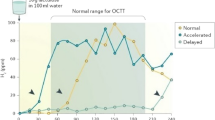Abstract
In twelve patients with culture-proven bacterial overgrowth of the small intestine, the ability of a newly-developed one-gramd-[14C]xylose breath test to detect bacterial overgrowth was compared to that of the [14C]bile acid breath test. All patients manifested excessive production of breath14CO2 after the administration of one gram [14C]xylose, with 83% of the patients being abnormal within the first hour of testing. In contrast, during the [14C]bile acid breath test, four of the twelve patients had no period of excessive14CO2 production (above the 95% confidence range of controls). Nutrient malabsorption (fat, cobalamin, xylose) was seen with both true-positive and false-negative bile acid breath tests. The one gram [14C]xylose breath test, utilizing a substrate with more predominant absorption in the proximal small intestine and which can be catabolized by Gram-negative aerobic bacteria, appears to have a greater degree of sensitivity and specificity than the bile acid breath test in detecting the presence of small-intestine bacterial overgrowth.
Similar content being viewed by others
References
Donaldson RM Jr: Small bowel bacterial overgrowth. Adv Intern Med 16:191–212, 1970
King CE, Toskes PP: Small intestine bacterial overgrowth. Gastroenterology 76:1035–1055, 1979
Northfield TC, Drasar B, Wright JT: Value of small intestinal bile acid analysis in the diagnosis of the stagnant loop syndrome. Gut 14:341–347, 1973
Egger G, Kessler JI: Clinical experience with a simple test for the detection of bacterial deconjugation of bile salts and the site and extent of bacterial overgrowth in the small intestine. Gastroenterology 64:545–551, 1973
Fromm H, Hofmann AF: Breath test for altered bile-acid metabolism. Lancet 2:621–625, 1971
Sherr HP, Sasaki Y, Newman A, Banwell JG, Wagner HN, Hendrix TR: Detection of bacterial deconjugation of bile salts by a convenient breath analysis technic. N Engl J Med 285:656–661, 1971
Fromm H, Thomas PJ, Hofmann AF: Sensitivity and specificity in tests of distal ileal function: Prospective comparison of bile acid and vitamin B12 absorption in ileal resection patients. Gastroenterology 64:1077–1090, 1973
Toskes PP, King CE, Spivey JC, Lorenz E: Xylose catabolism in the experimental rat blind loop syndrome: Studies including use of a newly developed14C-d-xylose breath test. Gastroenterology 74:691–697, 1978
King CE, Toskes PP, Spivey JC, Lorenz E, Welkos S: Detection of bacterial overgrowth in the human small intestine by means of a14C-d-xylose breath test. Gastroenterology 77:75–82, 1979
Winchell HS, Stahelin H, Kusubov N, Slanger B, Fish M, Pollycove M, Lawrence JH: Kinetics of CO2−HCO3 in normal adult males. J Nucl Med 11:711–715, 1970
Scholander PF: Analyzer for accurate estimation of respiratory gases in one-half cubic centimeter samples. J Biol Chem 167:235–250, 1947
James OFW, Agnew JE, Bouchier IAD: Assessment of the14C-glycocholic acid breath test. Br Med J 3:191–195, 1973
Turnberg LA, Anthony-Mote A: The quantitative determination of bile salts in bile using thin-layer chromatography and a 3 α hydroxy-steroid dehydrogenase. Clin Chim Acta 24:253–259, 1969
Hofmann AF: Thin-layer absorption chromatography of free and conjugated bile acids on silicic acid. J Lipid Research 3:127–128, 1962
Randerath K:In Thin-Layer Chromatography, 1968, Academic Press, New York, pp. 143–144
Pedersen L, Arnfred T, Thaysen EH: Rapid screening of increased bile acid deconjugation and bile acid malabsorption by means of the glycine-1-(14C) cholylglycine assay. Scand J Gastroenterol 8:665–672, 1973
Scarpello JHB, Sladen GE: Appraisal of the14C-glycocholate acid test with special reference to the measurement of fecal14C excretion. Gut 18:742–748, 1977
Lauterburg BH Newcomer AD, Hofmann AF: Clinical value of the bile acid breath test. Evaluation of the Mayo Clinic experience. Mayo Clin Proc 52:227–233, 1978
Farivar S, Fromm H, Schindler D, Schmidt FW: Sensitivity of bile acid breath test in the diagnosis of bacterial overgrowth in the small intestine with and without the stagnant (blind) loop syndrome. Dig Dis Sci 24:33–40, 1979
Metz G, Gassull MA, Drasar BS, Jenkins DJA, Blendis LM: Breath-hydrogen test for small intestinal bacterial colonisation. Lancet 1:668–669, 1976
Lennette EH, Spaulding EA, Truant JP: Manual of Clinical Microbiology. American Society for Microbiology. Washington, D.C., 2nd edition, 1974
Hill M, Drasar BS: Degradation of bile salts by human intestinal bacteria. Gut 9:22–27, 1968
Lewis R, Gorbach S: Modification of bile acids by intestinal bacteria. Arch Intern Med 130:545–548, 1971
Goldstein F, Mandle RJ, Schaedler RW: The blind loop syndrome and its variants: Microbiologic aspects of diagnosis and treatment. Am J Gastroenterol 60:255–264, 1973
Goldstein F: Mechanisms of malabsorption and malnutrition in the blind loop syndrome. (Editorial) Gastroenterology 61:780–784, 1971
King C, Toskes P: A caveat—Endogenous CO2 production increases during nonfasting carbon isotope breath tests. (abstract). Gastroenterology 74:1049, 1978
Hofmann AF, Lauterburg BH: Breath test with isotopes of carbon: Progress and potential. J Lab Clin Med 90:405–411, 1977
Author information
Authors and Affiliations
Additional information
Dr. King is the recipient of a Research Associate Award from the Veterans Administration. During the performance of these studies Dr. Toskes was the recipient of a Clinical Investigator Award from the Veterans Administration.
Supported in part by Grant #RR-82 from the National Institutes of Health.
Rights and permissions
About this article
Cite this article
King, C.E., Toskes, P.P., Guilarte, T.R. et al. Comparison of the one-gramd-[14C]xylose breath test to the [14C]bile acid breath test in patients with small-intestine bacterial overgrowth. Digest Dis Sci 25, 53–58 (1980). https://doi.org/10.1007/BF01312733
Received:
Revised:
Accepted:
Issue Date:
DOI: https://doi.org/10.1007/BF01312733




